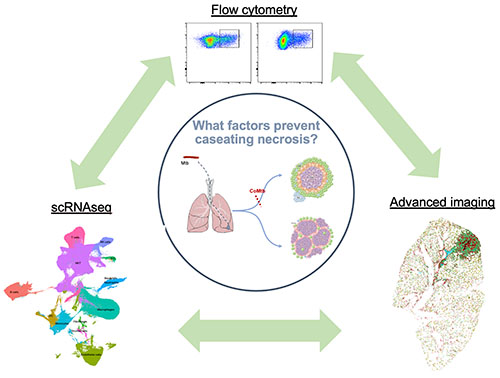Dissecting Granuloma Organization
 The stereotypic tuberculosis lesion is a granuloma with a necrotic core surrounded by a lymphocyte-rich cuff. In reality, tuberculosis can give rise to a broad spectrum of lesions, ranging from classic necrotic granulomas, all the way to pneumonia-like alveolitis. Autopsy studies from the pre-antibiotic era suggest that the presence of pre-existing immunity can skew lesions toward alveolitis. However, the mechanisms behind this observation, and the differences that occur within developing lesions to yield such a wide range of structures, are unclear.
The stereotypic tuberculosis lesion is a granuloma with a necrotic core surrounded by a lymphocyte-rich cuff. In reality, tuberculosis can give rise to a broad spectrum of lesions, ranging from classic necrotic granulomas, all the way to pneumonia-like alveolitis. Autopsy studies from the pre-antibiotic era suggest that the presence of pre-existing immunity can skew lesions toward alveolitis. However, the mechanisms behind this observation, and the differences that occur within developing lesions to yield such a wide range of structures, are unclear.
We are using a multimodal approach to understand what processes influence lesions to develop into such different structures. This approach includes multiple physiologic mouse models, human tissues, and advanced imaging techniques. This fundamental knowledge of what influences TB lesion development could inform the design treatments and vaccines to skew granulomas towards favorable structures.